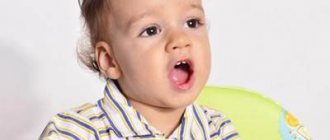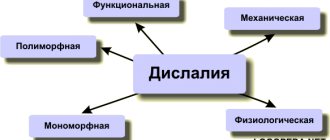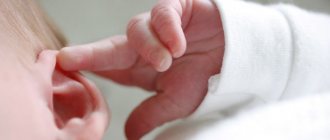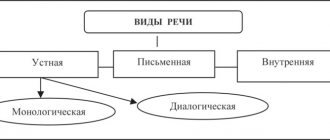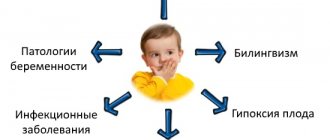Development of the sound-pronunciation aspect of speech in ontogenesis
Lidiya Sergeeva
Development of the sound-pronunciation aspect of speech in ontogenesis
The sound of speech is the minimal , indivisible speech unit. Sounds as material signs of language perform two functions: bringing speech to auditory perception and distinguishing significant units of speech (morphemes, words, sentences)
.
Establishing correct sound pronunciation is closely related to the development of better coordination of the organs of the articulatory apparatus of children. Researchers of children's speech emphasize that the sound side of speech is the means that allows each of the participants in verbal communication to convey to others the content of their thoughts, ask questions, and negotiate with peers about playing together. Phonetic observations of children on articulation create the basis not only for the formation of speech hearing, but also for the development of the culture of oral speech and its pronunciation aspect.
Sound pronunciation is the process of producing speech sounds , carried out by the coordinated work of three parts of the peripheral speech apparatus (respiratory, glottal and articulatory)
under regulation by
the central nervous system (central speech apparatus)
.
Correct sound pronunciation is not only the child’s pure pronunciation of each speech sound , but also his mastery of the patterns of combining these sounds in syllables and words . Mastery of this complex process occurs in two ways: informal - based on imitation of the speech of surrounding people and formal - as a result of special training.
According to E. L. Krutiy, the human speech apparatus is a complex structure centered in the brain. Many children have difficulty with some sounds , primarily because their phonemic hearing is not yet sufficiently developed , so they often do not recognize sounds in adult speech and reproduce them in a distorted form. Secondly, the child’s articulatory apparatus is still very unstable, and it is not so easy for him to cope with obstacles in the path of the air stream when he pronounces consonants .
In order for the desired sound , the tongue, lips and teeth must take a certain position (articulatory posture), and this is what a child sometimes fails to do, especially when pronouncing some whistling, hissing and sonorant sounds. Let us consider the features of the articulatory apparatus in order to determine the main difficulties in teaching preschool children sound pronunciation .
The most mobile organ is the tongue. It consists of the root (the base by which the tongue is attached to the hyoid bone)
and the back, which distinguishes between the front, middle and back parts.
Particularly noteworthy is the tip of the tongue, which seems to end the front part of the tongue, and the lateral edges of the front and middle parts of the tongue, since the quality of sounds . The front part of the back of the tongue and the tip of the tongue have the greatest degree of mobility: The tip of the tongue can fall behind the lower teeth (with the sounds [s , z], rise by the upper teeth (with the sounds [t , d), press against the alveoli (with the sound l , tremble under the pressure of the exhaled stream of air (with
the sound [r] ) .
The front part of the back of the tongue can rise without the participation of the tip of the tongue to the alveoli and form a gap with them (with the sounds [s , z, z], rise to the palate along with the tip of the tongue and form a gap with the hard palate (with the sounds [sh , sch, zh ])
.
The middle part of the back of the tongue is most limited in its movements. Without advancing the front or back of the tongue, it can only rise to the hard palate (with
the sound [th] and soft consonants) .
The back of the back of the tongue can rise and close with the palate (with
the sounds [k , g]) or form a gap with the palate
(with
the sound [x] ) .
The lateral edges of the tongue can be pressed against the inner surface of the molars and do not allow the sideways flow of air to pass (with sounds [s , z, c, sch, zh, h, sch, r])
;
can lower and pass a stream of air to the side (with
the sound l ) ;
the tongue may narrow, and its lateral edges will not touch the molars (with
the sounds [o , y]) . The mobility of the lips also plays an important role in the formation
of sounds . The lips can stretch into a tube (with the sound [u] , round, (with the sound [o] , expose the upper and lower front teeth (with the sounds [i , s, z, ts, l], etc., slightly move forward ( with
sounds [w , l]) .But the lower lip has the greatest mobility. It can close with the upper lip (with
sounds [p , b, m], form a gap, approaching the upper front teeth (with
sounds [f , v]) .
The lower jaw can lower and rise, changing the volume of the oral cavity with these movements, which is especially important when forming vowel sounds . The soft palate, or velum, can rise and fall. When the soft palate is lowered, the exhaled stream of air passes through the nose, resulting in the formation of nasal sounds [m , m', n, n']. If the soft palate is raised and the small tongue is pressed against the back wall of the pharynx, the passage into the nasal cavity is closed. The exhaled stream of air goes through the mouth and oral sounds (all except m, m', n, n')
[21, p.09].
Thus, when producing various sounds, each organ occupies a certain position. In speech, sounds are not pronounced in isolation, but one after another, so the organs of the articulatory apparatus must quickly change their position. Clear pronunciation of sounds , words, and phrases can be achieved if the organs of the articulatory apparatus are sufficiently mobile and their work is coordinated.
M. B. Eliseeva notes that the formation of speech development in a child occurs through three main stages. The first stage is called “preverbal”
.
It lasts from approximately birth to one year and is characterized by periods of humming and babbling. The second stage is the transition to active speech , which, as a rule, begins in the second year of a child’s life and is marked by the appearance of the first independent words and phrases. And only at the third stage, starting from the third year of life, does the baby master speech as a means of communication. sound pronunciation is established .
According to A. N. Gvozdev, reactions to sounds are observed in a hearing child immediately after birth. They are expressed in shaking of the whole body, blinking, changes in breathing and pulse. The first conditioned reflexes to sound stimuli are formed in children at the end of the first and beginning of the second month of life. They determine the direction of the sound and turn their heads in the direction of the sound . The development of the pronunciation aspect of speech originates from the first vocal manifestations (screaming and babbling)
.
In the third or fourth month of life, the child begins to differentiate qualitatively different sounds and homogeneous sounds of different pitches . The main semantic load at the age of 4 to 6 months is carried by intonation. In the subsequent months of the first year of life, further development of the auditory analyzer is noted. The child begins to more subtly distinguish the sounds of the surrounding world , the voices of people and respond to them in different ways. Those words and phrases that the child begins to “understand”
are perceived by him in an insufficiently dissected form and are not much different from other
sounds .
According to M. B. Eliseeva, further phonemic development occurs rapidly , constantly ahead of the child’s articulatory capabilities, which serves as the basis for improving pronunciation. The formation of the phonetic-phonemic system begins at the end of the first year of a child’s life. Since the phonetic-phonemic system is a product of the integration of the functions of the speech-auditory and speech-motor analyzers, the process of its formation is preceded by the development of auditory perception and the ability to reproduce sounds . According to A. N. Gvozdev [10], N. Kh. Shvachkin [41], by the end of the second year of life, when understanding speech , the child uses phonemic perception of all sounds of his native language .
Even during the period of babbling, the vocal elements already present in the child undergo qualitative changes. Gradually, vowel-like sounds are freed from noise components, their differentiation occurs by changing the series (a -> a, lifting (a - "g), labialization (a -" b). And at the end of the babbling period, the vocal elements turn into vowel sounds , and in the child the first opposition appears: vowel - consonant. Further development also occurs in consonant-like sounds , which lose their nasal overtone Sounds are differentiated according to the type nasal - oral ([t] - [r])
.
In addition to stop fricative sounds appear , then the child begins to pronounce sounds from different places of formation, realizing them in maximally contrasting syllables (V.I. Beltyukov, A.D. Salakhova, O.N. Usanova, etc.)
.
During the same period, the formation of articulatory oppositions begins along the lines of fricative - occlusive, voiceless - voiced, and towards the end of babbling - hard - soft. The sounds of babbling gradually acquire acoustic-articulatory definition and approach the phonetic structure of the native language. After two years, a period of accumulation of words occurs, which in turn leads to the need to distinguish them in the process of communication. Therefore, sounds in speech begin to acquire functional significance, which is associated with the consistent mastery of the system of oppositions used in the phonetic system of the language.
O. V. Gorbunova notes that the first to appear in verbal speech are hard labial [m], , [p], dentolingual [v] and posterior lingual sounds [k] , [g]. Of the soft sounds , the middle language [j] appears first. Subsequently, the following trend is observed: first, children pronounce soft variants of phoneme sounds , then hard ones. In this case, plosives precede the appearance of fricatives. Of the fricative sounds, the sounds of the lower rise - whistling - appear first , then the sounds of the upper rise - hissing. Lastly, children master occlusive-frictional and tremulous articulation.
Child of primary preschool age (from 2 to 4 years old)
has already mastered speech to a significant extent, but the speech is not yet clear enough in sound.
The most typical speech defect for children of this age is a softening of speech : “lezetska”
(spoon,
“syumotska” (handbag)
. Many three-year-old children do not pronounce hissing
sounds [sh , zh, ch, shch], replacing them with whistling sounds: “syuba"
( fur coat,
"syapka" (hat)
. Three-year-olds often do not pronounce
the sounds [r] and [l] , replacing them with others: "yuka"
,
"luka"
(instead of
"ruka"
,
vampa"
,
"yampa"
(instead of
"lamp") "
). There is a replacement of back-lingual
sounds with front-lingual ones : [k-t, g-d] ( "torova"
instead of
"cow"
,
"blow"
instead of
"walk"
, as well as deafening of voiced
sounds ( "shuk"
instead of
"zhuk"
).
Pronunciation of words at this age also has its own characteristics. A small child pronounces the same sound in one combination, but distorts it in another or completely misses it. For example, he easily pronounces the sound [r] in combination with vowel sounds (hand, rose, but does not pronounce in combination with consonants (tamvay - tram, klysha - roof)
.
In the Russian language, children have difficulty pronouncing two or three adjacent consonant sounds , and, as a rule, one of these sounds is either missed or distorted, although in isolation the child pronounces these sounds correctly. sound in a word , usually more difficult. Replaced by another found in the same word ( "mumaga"
,
"babaka"
,
"foraapparat"
, etc.) Sometimes these replacements are not related to the difficulty of pronouncing
the sound : simply one sound is likened to another, because the child caught it faster and remembered it . Very often, children rearrange sounds and syllables in words : “beak”
(cranberry),
“aplesin” (orange)
.
In middle preschool age (4-4.5 years)
in
speech almost disappears; it is observed only in a few. Most already have hissing sounds ([sh, zh, h], at first they sound unclean, but gradually children master them completely, although instability of pronunciation is characteristic of this age. Children pronounce sounds either correctly or incorrectly: “now”
, and after minute
"seitsas"
, or
"beetle zuzzit"
. In one
sound combination the child pronounces the sound , but in the other not yet. "Maltsik"
, and then
"clock"
. It is interesting that some children of this age have an excessively frequent use
of the sounds [p , sh, zh], when they move on to the correct pronunciation of these sounds , for example: “goruboy”
(blue),
“rodka”
(boat,
“shad”
(garden),
“zhontik” (umbrella)
, etc. The child replaces with a new
sound those sounds that themselves were previously substitutes... If instead of “r”
he pronounced
“l”
, now he makes the opposite replacement, not immediately understanding where it is needed and where it is not.
Most children of middle preschool age already pronounce the sound “r”
, but it is not yet sufficiently automated in
speech . The sound “r”
omitted in words; more often it is replaced by other
sounds : [l, l, th]. Children's word pronunciation at the age of 4-5 also becomes clearer. Like sound pronunciation , permutations and assimilation of sounds and syllables are less common, and abbreviations of words almost disappear.
E. A. Yanushko notes that the majority of children of senior preschool age (from 6 to 7 years old)
they speak correctly, but still some have unclean speech
(15-20%)
.
Speech deficiencies in this age group are expressed in the distortion of the hissing sounds Ш , Ж, Х, as well as F and L, and here there is no longer the instability characteristic of children of middle preschool age. Most often, older children replace one sound with another . Burr and lisp become habitual. More serious deviations are also encountered: stuttering, complex dyslalia, but they make up a relatively small percentage of all cases of speech defects. And yet, many 6-7 year old children experience incorrect placement of stress and “swallowing”
of word endings.
Often carelessness in word pronunciation is explained by imitation of the speech of adults : “yabloko”
,
“mine”
,
“walk”
,
“fatit”
.
The formation of sound pronunciation normally ends by 4–5 years.
In older preschool age, improvement of all aspects of the child’s speech . Pronunciation becomes clearer, statements - more precisely, phrases - more detailed . The enrichment and expansion of the vocabulary is carried out not only through nouns denoting objects, their properties and qualities, but also through the names of individual parts, details of objects, and verbs. Increasingly, collective nouns and adjectives appear in speech , denoting the material, properties, and state of objects. Over the course of a year, a child’s vocabulary increases by 1000-1200 words (compared to the previous age, although it is very difficult to practically establish the exact number of words learned during a given period. A child of the sixth year of life improves coherent, monologue speech. At the sixth year of life, children are able to correctly pronounce everything sounds of their native language ... However, some children at this age have just completed the correct assimilation of hissing sounds , sounds l , r. With their assimilation, children begin to clearly and distinctly pronounce words of varying complexity. The pronunciation side of the speech of children of the 7th year of life reaches a high level. Children must correctly pronounce all the sounds of their native language , pronounce phrases clearly and distinctly, and can speak quietly and loudly, in a whisper, depending on the situation.
The sound pronunciation of children of senior preschool age is characterized by a number of features:
1. Children have sound analysis and determine the place of sound in a word .
2. All sounds are pronounced correctly and clearly.
3. The replacement of hissing and whistling sounds .
sounds that are difficult to articulate (hissing and sonorant)
.
M. M. Alekseeva and co-authors note that in the sixth year they improve the articulation of sounds , differentiation of mixed sounds , and continue to develop speech perception ; cultivate the sound expressiveness of speech - develop the strength of the voice and its timbre, tempo and rhythm of speech , melody, skills in using different intonations. In the seventh year of life, the primary development of phonemic perception and sound analysis of words ; education of intonation and sound expressiveness of speech ; work on spelling correct speech.
Often, children also suffer from vowel sounds ; they pronounce them unclearly, as if blurring their sound. Meanwhile, the correct pronunciation of vowel sounds is very important , since vowels serve as the basis for the development of the skills of sound , sound-syllable , sound-letter analysis , which prepares the child for learning to read and write. In addition, systematic exercises with vowel sounds serve as speech gymnastics, promoting the development of coordinated movements of the speech : the development of speech breathing , voice and diction. Sound pronunciation defects do not disappear on their own. However, under favorable learning conditions, children are capable of self-correction.
We can conclude about the sequence of development of sound pronunciation in ontogenesis :
At the 2nd month development , undifferentiated and involuntary vocal reactions appear, arising in the process of movement - this is humming. We can distinguish vowels: a, o, y, e, consonants p, m, k, g, x.
At 3-4 months, babbling appears.
5 months – unconscious appearance of sounds and their complexes .
6 months – imitative repetition of individual rhythmic syllables.
8 months – pronounces 8 syllables formed by repeating the same syllable (babble)
.
1-2 years – vowels o, a, e, consonants p, b, m appear. Age-specific deficiencies in sound pronunciation – omission (ellisis)
consonants in conjunctions and in polysyllabic words;
adding vowels between consonants when they come together, and at the end of words ending in consonants . Assimilation of sounds in a word (assimilation)
- if a word has 2-3 consonants, then difficult consonants are replaced with simpler consonants found in the same word.
There may also be assimilation of vowel sounds . Softening consonants . Replacement (substitution)
of consonant
sounds , including in terms of voicedness and deafness. Metathesis of sounds (rearrangement
of sounds ) .
At 2-3 years old - vowels [s] and [y], consonants [f v t dn k g x y]. The errors indicated for the age of 1-2 years remain, but in smaller quantities.
3-4 years - The errors indicated for the age of 1-2 years remain, but in even smaller quantities.
4-5 years old – whistling [з с ц], hissing [шж ж ш]. Of the errors, substitutions of some of the most complex consonants are preserved.
5-6 years old - sounds [r l] .
By the end of the preschool period, children should have developed phrasal speech , phonetically, lexically and grammatically correct. The level of development of phonemic hearing allows them to master the skills of sound analysis and synthesis , which is a necessary condition for mastering literacy during the school period. As A. N. Gvozdev noted, by the age of seven, a child masters speech as a full-fledged means of communication (provided the speech apparatus is intact, if there are no deviations in mental and intellectual development , if the child is brought up in a normal speech and social environment).
Thus, we can conclude that the formation of the pronunciation side of speech is a complex process during which the child learns to perceive sounding speech addressed to him and control his speech organs to reproduce it. Speech is formed in a child gradually, along with his growth and development , and goes through a number of qualitatively different stages of development . The newborn may make involuntary sounds . They are innate, the same for children of all nations, despite differences in languages and cultures. These sounds are the precursors to speech . The problem of developing sound pronunciation in preschoolers is relevant, since the development of this process has a positive effect on the development of the entire speech system, therefore there is a need for early identification of children with phonetic-phonemic speech underdevelopment and providing them with speech therapy assistance in specially organized conditions.
Patterns of normal speech development according to A. N. Gvozdev
The proposed scheme is based on the peculiarities of the appearance of parts of speech and grammatical categories in children. A. N. Gvozdev distinguishes two stages:
- use of amorphous words;
- mastery of grammatical categories.
When constructing correctional work, speech therapists rely on these patterns of ontogenetic speech development.
Amorphous root words
A. N. Gvozdev begins to consider the acquisition of the native language system from one year and 8 months, when the baby already has his first words. This stage is divided into two sub-periods, each of which has its own characteristics.
- One-word - the baby uses only individual words that act as sentences. Some of them serve to express his desires and feelings. At this time, he actively uses facial expressions and gestures. The first words do not have a clear grammatical form: he uses them in one sound image in different contexts (“bi” - car, driving, etc.).
Most of them are nouns, onomatopoeic complexes and babble. In total, the child’s dictionary during this period contains about 29 such amorphous words. He clearly pronounces vowels, labiolabials, front-lingual, back-lingual, Сь, Ль. The syllabic structure consists of one stressed syllable or two identical ones.
- The second sub-period is characterized by combining words into one phrase, but it is ungrammatical. Indeclinable nouns and verbs appear in the form of the imperative mood (“drink”, “give”, etc.). The syllable structure becomes more complex: the baby learns the pronunciation of two-syllable words. Хь, Ц, И appears, sometimes he may omit a sound at the beginning or end of a word. The baby also masters the pronunciation of consonant clusters that appear in the middle of some words.
During this age period, the prerequisites for the child’s successful mastery of the components of the language system are formed. He begins to use the simplest forms of parts of speech and sounds with simple articulation patterns.
Mastering the grammatical structure of sentences
This long period begins at 1 year 8 months. and lasts up to 6 years. The child masters all grammatical skills; The syllable structure and sound pronunciation are fully formed by the age of 5-6 years. Children are actively engaged in word creation. This phenomenon is caused by attempts to master the norms of the native language without knowing the grammatical rules.
First period
First forms of words (1 year 8 months – 2 years). The baby combines 3-4 words into a sentence. He masters the skill of agreeing a noun in the nominative case with a verb, and the initial signs of adjective subordination appear. Phrase speech itself is characterized by ungrammaticality.
Begins to decline words according to cases (nominative, accusative, prepositional); adds diminutive suffixes; new inflections of verbs appear; often omits prefixes.
During this period, the first adjectives appear, but the child uses them without agreement with the noun. Adverbs and pronouns appear (he speaks about himself in the 3rd person); particles. In three-syllable words the child omits the pre-stressed syllable, but in four-syllable words the syllable structure is most often preserved.
Articulatory structures N, T, D appear. Most of the consonant clusters are replaced by a single phoneme.
Second period
From 2 years to 2 years 6 months. endings are learned and conjunctions are added to sentences. A common mistake is replacing endings and using them within the same meaning. Suffixes, dative and instrumental cases appear. Begins to inflect verbs according to persons and tenses, but can mix gender.
The number of adjectives increases, but when using them, the child violates the norms of agreement. The plural form is used only in the nominative case. Personal pronouns are being learned; adverbs that are used for comparison. More prepositions and complex conjunctions appear.
In complex words, omission of pre-stressed syllables and prefixes is most common. The child often mixes similar phonemes in speech. The sequence of consonants remains unlearned, but he pronounces some groups correctly.
Third period
From 2.6 months By the age of 3 years, the child masters the functional parts of speech. The structure of the sentence becomes more complex, and the skill of subordinating words appears. But the child has not yet mastered the category of gender. Almost all the main case endings have been mastered, but the influence of O is more common in them. Suffixes denoting increase are being mastered.
The child freely uses all forms of reflexive verbs and prefixes. But sometimes he can mix them up. Begins to use coordination skills when constructing sentences. Forms of short participles appear. The child confuses possessive pronouns. Uses prepositions and most conjunctions correctly.
Distortion of syllable structure is rare, most often in unfamiliar words. Articulatory patterns of hissing sounds are formed; the pronunciation of consonant sequences is learned.
The fourth period
At 3-4 years old, agrammatic sentences become less and less common in children’s speech. The child is actively engaged in word creation. The ending -OV continues to influence the declination. Difficulties arise in agreeing neuter adjectives. The comparative degree of adjectives and adverbs, the particle BY, appears. The pronunciation side is fully formed.
Fifth period
The period from 4 to 6 years is characterized by the acquisition of almost all grammatical forms of parts of speech. The child has difficulty making sentences with the word “which”.
The boundaries of all the listed stages are approximate; everything depends on the individual characteristics of the child, on the conditions of the speech environment in which he grows. Thanks to knowledge of the stages of ontogenetic development of speech, it is possible to determine how the process of assimilation of language components proceeds. Taking into account ontogenetic and mental characteristics, speech therapists carry out correctional work.
